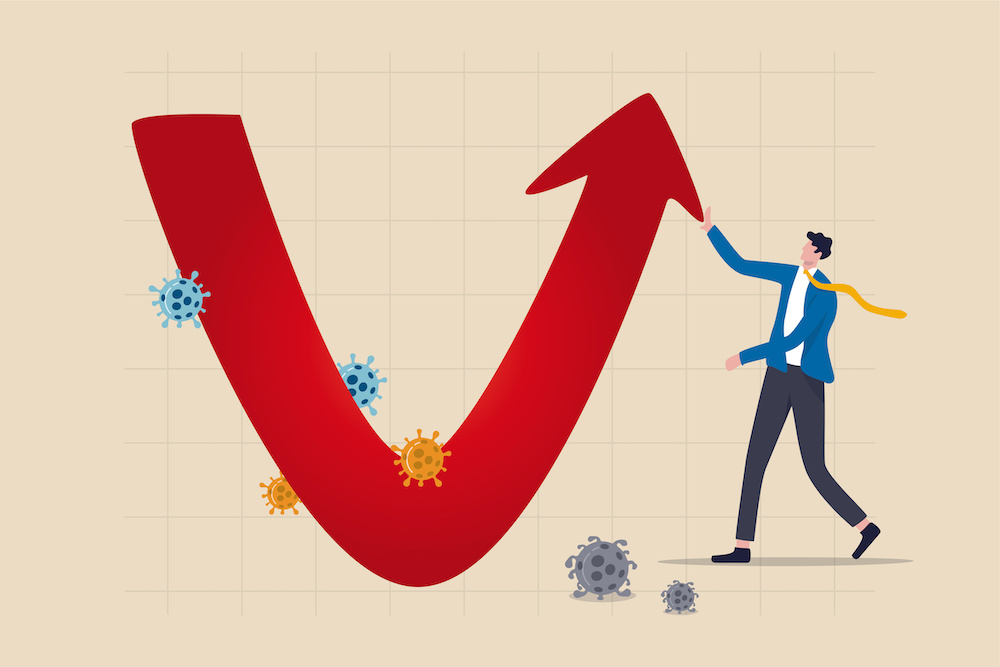The ‘V-shaped’ economic recovery is most powerfully evident in Australian monthly employment data since the beginning of the pandemic. Just before the employment losses from the pandemic total employment peaked at 13.009 million people in February 2020. Total employment collapsed by 878,200 to 12.131 million in May 2020 at the low point but in February 2021 had risen 876,400 from the low point to 13.007 million.
Employment has recovered much faster than expected and in February 2021 stood 2,000 below where it was before the pandemic recession. When the March data are released in mid-April total employment will be above the February 2020 mark.
While the employment recovery has been more distinctly ‘V-shaped’ than anyone expected it still needs to go further to be a ‘complete employment recovery’ as it is not enough just to recover jobs lost in the recession.
Complete employment recovery needs total employment to rise beyond the pre-pandemic February 2020 peak. Before Covid-19 total employment was rising close to 3% annually or 350,000. That means if the pandemic had not occurred and the economy managed to grow between February 2020 and February 2021 at the same pace as the year before, total employment in February 2021 would have been around 13.360 million.
Total employment in February 2021 is effectively still 352,000 below complete recovery using this calculation. Moreover, the complete employment recovery bar is lifting 30,000 each month. Total employment needs to grow at least 30,000 each month to cut into the growing complete employment recovery total, an objective well exceeded last month when employment rose by 88,700.
If total employment rose at similar pace over coming months complete employment recovery would occur in August this year.
In reality, employment will not continue to rise at the February pace. The planned end to job-keeper at the end of March will cut into employment growth starting with the April 2021 employment reading and most pronounced in the May 2021 data. Some industries are struggling and it is only job-keeper that is allowing them to keep people employed.
Yet far more industries are performing well in the current economic recovery attested to by fast rising job vacancies. Job losses when job-keeper ends will be offset in part and perhaps in full by rising employment in the many industries where conditions are improving.
In net terms, total employment may show no gain in April and May or even small losses, but ahead of big monthly employment gains beyond. Complete employment recovery may be set back a few months from August to December 2021 or early-2022. On that time scale it is occurring many months earlier than expected in the latest RBA economic forecasts.
Yet complete employment recovery does not imply an unduly tight labour market. It means only that total employment is where it would have been if the pandemic had not happened and the economy had continued to grow as it had been growing in early 2020. Early-2020 annual employment growth would have drifted down the unemployment rate from where it stood in February 2020, 5.1%, to about 4.8% in February 2021. That unemployment rate is low, but not low enough to trigger untoward inflation concern at the RBA.
If complete employment recovery is achieved by December 2021/early-2022 the unemployment rate should fall to around 4.8% in the same time period. This is below the RBA’s latest February 2021 set of economic forecasts showing an unemployment rate of 6.0% for December 2021 and 5.5% for June 2022, but those forecasts rendered overly pessimistic by the latest 5.8% unemployment rate reading for February 2021.
While the unemployment rate is falling faster than forecast by the RBA and will necessitate downward revisions in the RBA’s next set of economic forecasts to be published in May it may take longer before the RBA forecasts a sub-5% unemployment rate, probably not until late 2021/early 2022, even though we see a case building for such a change to their unemployment rate forecast.
Even when the RBA forecasts a sub-5% unemployment rate that is not sufficient for the RBA to change materially its forecast of slow-pick up in annual wages growth and annual inflation. The RBA is on record saying that the unemployment rate can fall to 4% before generating tightness in the labour market consistent with faster wages growth and consistent pressure on the upper end of the 2 to 3 per cent annual inflation target band.
Nevertheless, the more pronounced employment ‘V’ has lowered the unemployment rate to a level that the RBA had not expected to see on its latest forecasts until early 2022. It follows that low wages growth and low inflation will not persist as long as the RBA was forecasting in February.
There is still no case from rising wages to push the RBA to lift the cash rate this year or much of next year but as employment continues to recover and the unemployment rate pushes below 5% by early-2022, the RBA’s guidance of no increase in the cash rate before 2024 at earliest, will become less credible. The issue is not so much when the RBA will lift the cash rate as when the RBA will change its guidance about the timing of the first rate hike in the next cycle. The better-than-expected employment growth may force at least a rate guidance change by early 2022.

